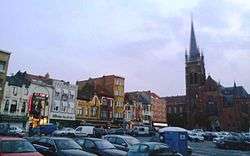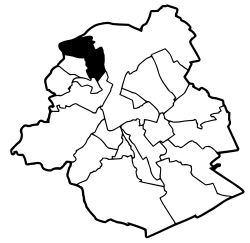Jette
| Jette | |||
|---|---|---|---|
| Municipality | |||
 | |||
| |||
 Jette Location in Belgium
Jette municipality in the Brussels-Capital Region  | |||
| Coordinates: 50°52′N 04°20′E / 50.867°N 4.333°ECoordinates: 50°52′N 04°20′E / 50.867°N 4.333°E | |||
| Country | Belgium | ||
| Community |
Flemish Community French Community | ||
| Region | Brussels | ||
| Arrondissement | Brussels | ||
| Government | |||
| • Mayor | Hervé Doyen (cdH) | ||
| Area | |||
| • Total | 5.04 km2 (1.95 sq mi) | ||
| Population (1 January 2017)[1] | |||
| • Total | 51,933 | ||
| • Density | 10,000/km2 (27,000/sq mi) | ||
| Postal codes | 1090 | ||
| Area codes | 02 | ||
| Website | www.jette.be | ||
Jette (French pronunciation: [ˈʒɛt]; Dutch pronunciation: [ˈjɛtə] (![]()
The Vrije Universiteit Brussel, the Dutch-speaking university of Brussels has built its hospital and medical campus in Jette, while its other buildings are in the so-called Etterbeek campus actually located in Ixelles/Elsene.
History
Origins to Middle Ages
Neolithic tools and remains of a Gallo-Roman villa have been found on the territory of Jette, proving the old age of the first settlements in this area. The fact that its first church was dedicated to Saint Peter also indicates early Christianization. During the Middle Ages, parts of the territory were feudal dependencies of the Duchy of Brabant. Under the duke’s protection, the Abbey of Dieleghem was founded in 1095 by the Bishop of Cambrai and administered by Augustinian canons. In 1140, the abbey’s monks switched to the rules of the Premonstratensian order. In the 13th century, the abbey now called Dieleghem possessed half of the commune’s territory and played an important social and economic role until the French Revolution.
17th to 20th century
During the “Old Regime”, Jette was part of the town of Merchtem. In the 17th century, the minister of finances under Archdukes Albert and Isabella acquired and refurbished the old 12th century Rivieren castle in Ganshoren, near Jette. In 1654, the minister’s son made this estate into a barony, then five years later into a county, which included Jette and several neighbouring villages.
In the 1790s, the regime that was put in power by the French Revolution curtailed the religious freedoms drastically. The monks were expulsed from the abbey in 1796 and most of the buildings demolished the following year. Only the abbott’s house was kept, as a leisure house. In 1841, the village of Ganshoren split from Jette. During the following decades, what remained of Jette gradually lost its rural character to become a Brussels suburb. Its population, which was around 10,000 in 1900 grew to more than 40,000 in 1971.
Sights
- The Jette city hall, Jules Van Ysendyck’s masterpiece, dates from the beginning of the 20th century.
- The only extant building of the Abbey of Dieleghem has been converted into a mostly historical museum.
- Jette has kept a few of its old pubs and breweries, as well as a blacksmith’s workshop that still operated until 1960.
- The René Magritte Museum was set up in the house where the famous painter lived and worked for twenty-four years.
 Jette railway station
Jette railway station Jette town hall
Jette town hall
Famous inhabitants
- René Magritte, surrealist painter (1898–1967)
- Jean Roba, comics author, creator of Boule et Bill (1930–2006)
- François Narmon (b. Jette, 1934), businessman
- Thomas Chatelle, football player (b. 1981)
- Jason Denayer, football player (b. 1995)
- Eric Ghysels, economist (b. 1956)
Partner cities
See also
References
- ↑ Population per municipality as of 1 January 2017 (XLS; 397 KB)
External links
| Wikimedia Commons has media related to Jette. |
- Official website (in French) (in Dutch)


